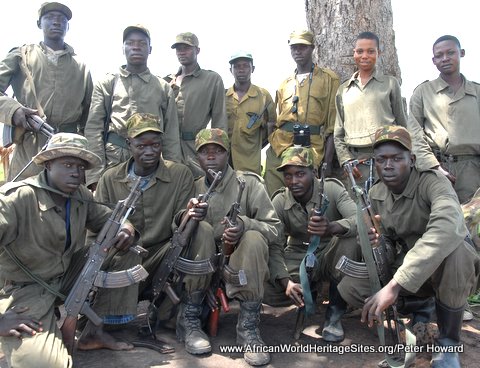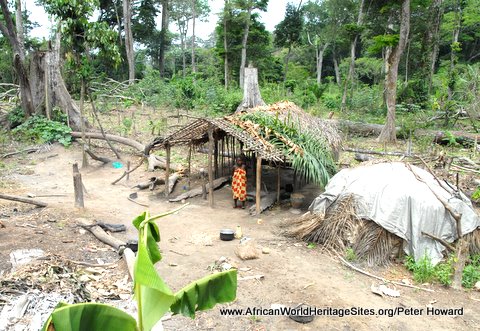




Sites In Danger
Unfortunately, Africa has more than its fair share of world heritage sites inscribed on the official List of World Heritage In Danger. Of the 39 sites on the global Danger list, 17 (44%) are in Africa (see list below). Four additional African sites have been included on the Danger List in the past, but are now sufficiently recovered to allow their removal. The high number of African sites reflects the particular challenges of this continent, especially the occurrence of periodic civil unrest and war. Twelve of Africa’s endangered sites are natural, while only three are cultural. Cultural sites normally fare better than natural ones through periods of unrest as there is normally no reason for wilfully damaging them. In general they are more likely to be threatened by accidental damage or structural deterioration due to neglect. But the recent destruction of some of the famous mausoleums in the ancient Malian town of Timbuktu show that religious extremism can also contribute to the loss of heritage.

Main Threats to Africa’s World Heritage Sites
Some of the threats to specific places are highlighted in the corresponding page of the website, but here is an overview of the ‘Top 10’ key threats affecting Africa’s world heritage sites. In some cases, a threat associated with a particular place has not yet reached levels that warrant a site’s Danger listing, but early recognition of emerging issues should help keep sites off the list.
Mining and mineral exploitation. The present boom in commodity prices has resulted in a huge surge in mineral exploration activity across Africa and, despite the provisions of the Convention, many governments regard world heritage sites as legitimate places for exploration. Sites that are currently threatened by mining or mineral exploration (inside their boundaries or close-by) include Mount Nimba, the Rwenzori Mountains, Virunga, Lake Turkana, Banc D’Arguin, iSimangaliso, Mana Pools and Selous.


Poaching, logging and resource exploitation. Most natural sites are affected to some extent by illegal hunting and other forms of resource use, but this only becomes a serious problem when the level of off-take exceeds the natural replenishment rate. Large mammals that are targeted for their valuable trophies, such as rhino and elephant are particularly vulnerable, and have been seriously affected by poaching (or eliminated altogether) in world heritage sites across the continent – from Mana Pools to Selous and Serengeti; and from Garamba and the other Congolese sites to Manovo-Gounda and Niokolo-Koba. Commercial exploitation of wildlife for meat is common in the Congo Basin and across the whole of West Africa, and there is probably not a single world heritage site in this part of the continent that has more than a fraction of its ‘natural’ populations of target species – including monkeys, antelope and larger rodents.


Accidental loss. Accidents happen, and cultural heritage sites are particularly vulnerable to fire. The Tombs of the Buganda Kings at Kasubi were raised to the ground by fire in 2010, and parts of the Abomey Palaces suffered a similar fate in 2009


Natural phenomena, neglect and abandonment. Allowing nature to ‘take its course’ is usually appropriate in the case of natural heritage sites, but is a recipe for disaster for cultural places. As any property-owner will attest, man-made structures require constant maintenance to keep them in good order and reverse the effects of wind, rain, storm, and the damage inflicted by colonising plants and animals. Much of Africa’s built heritage has been abandoned as civilisations have passed, and it has generally succumbed to the forces of nature quite quickly on account of the construction materials used. While the massive dry-stone walls of Great Zimbabwe are a notable exception, little remains of comparable sites elsewhere, such as Mapungubwe, Khami, or Loropeni. And it is worth noting that the natural threats to built heritage are ever-present and continue to cause damage almost as fast as it can be repaired. No sooner have funds been secured to restore the abandoned Swahili port of Kilwa (Tanzania), than another crisis arises in Madagascar where a cyclone recently damaged the enclosure wall and palace roof at Ambohimanga.
The List Of African World Heritage Sites In Danger
The List of World Heritage in Danger includes the following African sites. Danger listing should serve as a ‘wake-up’ call to the international community to mobilise all necessary diplomatic, financial and technical resources to ameliorate – wherever possible - the threats to this irreplaceable heritage, and accelerate the pace of repairing the damage inflicted as a result of civil unrest.
Manovo-Gounda St Floris National Park (Central African Republic) was added to the Danger list in 1997 on account of the worsening security situation in the north of the country and the inability of park authorities to operate effectively in combating threats to the property. Poaching escalated and most of the larger mammals have been killed in subsequent years. There is still no immediate prospect of improvement as the area remains insecure and most of the park infrastructure has been destroyed
Mount Nimba Strict Nature Reserve (Cote D’Ivoire) was added to the Danger list in 1992 on account of the threat from mining. A large part of the original trans-boundary reserve, on the Guinean side of the border, was de-gazetted to allow for a major open cast iron-ore mining operation to be undertaken in the higher reaches of the mountain. As much of the mountain consists of high-grade iron ore, there remains a very real risk of further excisions and total destruction of much of the higher-elevation forest, grasslands and unique biodiversity. The Liberian ‘end’ of the range has already been extensively damaged by similar mining operations in the past.
Comoe National Park (Cote D'Ivoire) was added to the Danger list in 2003 as Cote D’Ivoire broke down into civil war and the park and surrounding areas fell into the hands of ‘rebel’ forces. Most park staff were withdrawn and poaching escalated. Although the war is now over, much of the park infrastructure has been destroyed, park access roads are no longer accessible and park staff are only slowly returning to their posts. It will take many years – even under the best of circumstances – for wildlife populations to recover.
Sites in the Democratic Republic of the Congo. All of Congo’s world heritage sites have suffered as an indirect result of the rebellion which led to the overthrow of President Mobutu in the mid-90s; turmoil surrounding the Rwandan genocide and associated influx of refugees; followed by subsequent periods of civil unrest. Parks in the east of the country have been worst affected, but even Salonga National Park was added to the danger List in 1999. Earlier, Virunga National Park was In Danger by 1994, quickly followed by Garamba National Park in 1996, and both Kahuzi-Biega National Park and Okapi Wildlife Reserve in 1997.
Abu Mena (Egypt) was added to the Danger list in 2001 as many of the ancient structures began to suffer as a result of subsidence associated with a rising water-table because of new irrigation and agricultural development in the area. Efforts are being made to counteract this by improving drainage and shoring up the affected buildings. But an effective long-term solution has not yet been achieve.JPG)
Simien National Park (Ethiopia) was added to the Danger list in 1996 as rebel armies took control of this region of northern Ethiopia and the park suffered a further influx of people, threatening the habitat of the Simien fox, Walia ibex and other critically endangered endemic wildlife. Although wildlife populations are now recovering well, there is still some way to go in achieving long-term sustainable management for the park and re-establishing viable populations of key species.
Mount Nimba Strict Nature Reserve (Guinea) was added to the Danger list in 1992 as a result of the mining threat, as detailed under the entry for this site under Cote D’Ivoire (above)
Rainforests of the Atsinanana (Madagascar) were added to the Danger list in 2010 on account of political and civil unrest throughout the country, the withdrawal of much international aid (including funds that were critical to the management of the various separate forests that make up the property), and an escalating problem of illegal timber cutting.
Air and Tenere Natural Reserves (Niger)was added to the Danger list in 1992 as the area fell under the control of rebel Tuareg groups and government lost control. Most of the large mammals and other endangered wildlife has subsequently been destroyed.
Niokolo-Koba National Park (Senegal) was added to the Danger list in 2007 in response to a pervasive deterioration in management capacity and the decline of large mammal populations as a result of poaching.
Ruins of Kilwa Kisiwani and Ruins of Songo Mnara (Tanzania) was added to the Danger list in 2004 as a result of a general deterioration of the structures and lack of capacity to take remedial action.
Tombs of Buganda Kings at Kasubi (Uganda) was added to the Danger list in 2010 following its destruction by fire.
Timbuktu and the Tomb of Askia (Mali) were added to the Danger list in 2012 following the willfull destruction of some of the ancient mausoleums in Timbuktu by religious extremists seeking to establish their own fundamentalist Islamist state in northern Mali
African sites previously included on the Danger List
The Rwenzori Mountains National Park (Uganda) was added to the Danger List in 1999 when a rebel insurgency resulted in loss of management control and closure of the park to visitors. Peace was subsequently restored and the park removed from the Danger List in 2004
Djoudj National Bird Sanctuary (Senegal) was included on the Danger List between 2000 and 2006 on the basis of threats from invasive species of aquatic plant, and problems of salinity and siltation associated with the construction of dams and sluices to control the flow of the Senegal River.
Ichkeul National Park (Tunisia) was included on the Danger List between 1996 and 2006 due to salinity problems resulting from the damming of inflowing rivers. This affected the ecology of the lake severely, reducing the quantity of freshwater plant life and the populations of over-wintering waterfowl. These have never fully recovered.
Ngorongoro Conservation Area (Tanzania) was one of the first sites to be inscribed on the List of World Heritage In Danger, from 1984-89, due to a deterioration in its general ecological condition resulting from poor management.
.jpg)
